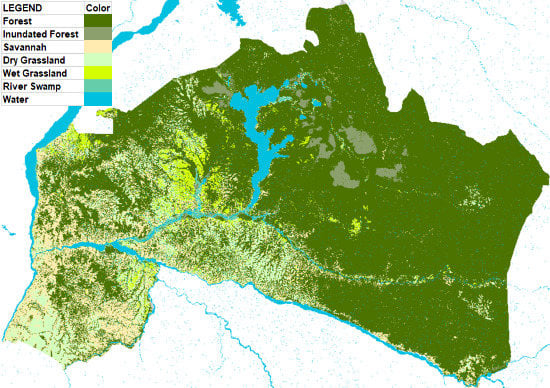Multi-Temporal and Multi-Frequency SAR Analysis for Forest Land Cover Mapping of the Mai-Ndombe District (Democratic Republic of Congo)
Abstract
1. Introduction
2. Materials and Methods
2.1. Region of Interest (ROI): Mai-Ndombe District in DRC
2.2. Satellite Data
2.2.1. Sentinel-1 A and B CSAR (2015–2017)
2.2.2. ALOS PALSAR (2007–2010) and ALOS-2 PALSAR-2 (2015–2017)
2.3. Pre-Processing and Mosaicking
2.4. Maximum-Likelihood Classification into Forest and Land Covers (FLC)
- The yearly averaged SAR backscatters, i.e., the three variables per sensor; mean(γ°[copol2017]), mean(γ°[xpol2017]), and NDI2017 for the year 2017.
- The multi-year averaged SAR backscatters, i.e., the three variables per sensor mean(γ°[copol2015–2017]), mean(γ°[xpol2015–2017]), and NDI2015–2017 for the years 2015–2017.
- The seasonally averaged backscatter for the dry and wet seasons, i.e., four variables per sensor; mean(γ°[copoldry]), mean(γ°[xpoldry]), mean(γ°[copolwet]), and mean(γ°[xpolwet]).
- The statistical parameters mean and variance from the three-year period 2015–2017, four variables per sensor; mean(γ°[copol2015–2017]), mean(γ°[xpol2015–2017]), var(γ°[copol2015–2017]), and var(γ°[xpol2015–2017]).
2.5. Validation and Inter-Comparison Approach
3. Results
4. Discussion
4.1. Inter-Comparison between Single and Multi-Frequency SAR Results
4.2. Comparision with Global Forest Maps
5. Conclusions
Author Contributions
Funding
Acknowledgments
Conflicts of Interest
References
- Van der Werf, G.R.; Morton, D.C.; DeFries, R.S.; Olivier, J.G.J.; Kasibhatla, P.S.; Jackson, R.B.; Collatz, G.J.; Randerson, J.T. CO2 emissions from forest loss. Nat. Geosci. 2009, 2, 737–738. [Google Scholar] [CrossRef]
- Gullison, R.E.; Frumhoff, P.C.; Canadell, J.G.; Field, C.B.; Nepstad, D.C.; Hayhoe, K.; Avissar, R.; Curran, L.M.; Friedlingstein, P.; Jones, C.D.; et al. Tropical Forests and Climate Policy. Science 2007, 316, 985–986. [Google Scholar] [CrossRef] [PubMed]
- The United Nations Framework Convention on Climate Change (UNFCCC). 2015 Paris Agreement English. Available online: https://unfccc.int/files/meetings/paris_nov_2015/application/pdf/paris_agreement_english_.pdf (accessed on 27 September 2019).
- Sukhdevb, P.; Prabhua, R.; Kumara, P.; Bassic, A.; Patwa-Shaha, W.; Entersa, T.; Labbatea, G.; Greenwalta, J. REDD+ and a Green Economy: Opportunities for a Mutually Supportive Relationship, UN-REDD Programme Policy Brief 2012, Issue #01. Available online: https://theredddesk.org/sites/default/files/resources/pdf/2012/unep_policy_brief.pdf (accessed on 27 September 2019).
- Herold, M.; Skutsch, M. Measurement, Reporting and Verification for REDD+: Objectives, Capacities and Institutions. In Realising REDD+: National Strategy and Policy Options; Angelsen, A., Brockhaus, M., Kanninen, M., Sills, E., Sunderlin, W.D., Wertz-Kanounnikoff, S., Eds.; Center for International Forestry Research (CIFOR): Bogor, Indonesia, 2009; pp. 85–100. ISBN 978-6-02-869303-5. [Google Scholar]
- Hansen, M.C.; Potapov, P.V.; Moore, R.; Hancher, M.; Turubanova, S.A.; Tyukavina, A.; Thau, D.; Stehman, S.V.; Goetz, S.J.; Loveland, T.R.; et al. High-Resolution Global Maps of 21st-Century Forest Cover Change. Science 2013, 342, 850–853. [Google Scholar] [CrossRef] [PubMed]
- Shimabukuro, Y.E.; Santos, J.R.; Formaggion, A.R.; Duarte, V.; Rudorff, B.F.T. The Brazilian Amazon monitoring program: PRODES and DETER projects. Glob. For. Monit. Earth Obs. 2012. [Google Scholar] [CrossRef]
- Instituto Nacional de Pesquisas Espaciais (INPE). Degrad. Available online: http://www.obt.inpe.br/OBT/assuntos/programas/amazonia/degrad (accessed on 27 September 2019).
- Instituto Nacional de Pesquisas Espaciais (INPE). Deter. Available online: http://www.obt.inpe.br/OBT/assuntos/programas/amazonia/deter (accessed on 27 September 2019).
- Global Forest Observations Initiative (GFOI). Available online: http://www.fao.org/gfoi (accessed on 27 September 2019).
- Carter, S.; Herold, M. Activities and Research Priorities of the GFOI R&D Coordination Component 2019; Global Forest Observations Initiative (GFOI): Rome, Italy, 11 February 2019; Available online: http://www.gofcgold.wur.nl/documents/GFOI/GFOI_RD_Priorities_2019.pdf (accessed on 11 December 2019).
- Global Forest Observations Initiative (GFOI). Integration of Remote-Sensing and Ground-Based Observations for Estimation of Emissions and Removals of Greenhouse Gases in Forests: Methods and Guidance from the Global Forest Observations Initiative, Edition 2.0; Food and Agriculture Organization: Rome, Italy, 2016; Available online: https://www.fs.fed.us/nrs/pubs/jrnl/2016/nrs_2016_penman_001.pdf (accessed on 11 December 2019).
- Reiche, J.; Lucas, R.; Mitchell, A.L.; Verbesselt, J.; Hoekman, D.H.; Haarpaintner, J.; Kellndorfer, J.M.; Rosenqvist, A.; Lehmann, E.A.; Woodcock, C.E.; et al. Combining satellite data for better tropical forest monitoring. Nat. Clim. Chang. 2016, 6, 120–122. [Google Scholar] [CrossRef]
- Hoekman, D.H.; Vissers, M.A.M.; Wielaard, N. PALSAR Wide-Area Mapping of Borneo: Methodology and Map Validation. IEEE J. Sel. Top. Appl. Earth Obs. Remote Sens. 2010, 3, 605–617. [Google Scholar] [CrossRef]
- Almeida-Filho, R.; Shimabukuro, Y.E.; Rosenqvist, A.; Sánchez, G.A. Using dual-polarized ALOS PALSAR data for detecting new fronts of deforestation in the Brazilian Amazônia. Int. J. Remote Sens. 2009, 30, 3735–3743. [Google Scholar] [CrossRef]
- Haarpaintner, J.; Almeida-Filho, R.; Shimabukuro, Y.E.; Malnes, E.; Lauknes, I. Comparison of ENVISAT ASAR deforestation monitoring in Amazônia with Landsat-TM and ALOS PALSAR images. In Proceedings of the Anais XIV Simpósio Brasileiro de Sensoriamento Remoto, Natal, Brasil, 25–30 April 2009; INPE: Brasilia, Brasil, 2009; pp. 5857–5864. [Google Scholar]
- Mermoz, S.; Le Toan, T. Forest Disturbances and Regrowth Assessment Using ALOS PALSAR Data from 2007 to 2010 in Vietnam, Cambodia and Lao PDR. Remote Sens. 2016, 8, 217. [Google Scholar] [CrossRef]
- Mermoz, S.; Réjou-Méchain, M.; Villard, L.; Le Toan, T.; Rossi, V.; Gourlet-Fleury, S. Decrease of L-band SAR backscatter with biomass of dense forests. Remote Sens. Environ. 2015, 159, 307–317. [Google Scholar] [CrossRef]
- Reiche, J.; Verhoeven, R.; Verbesselt, J.; Hamunyela, E.; Wielaard, N.; Herold, M. Characterizing Tropical Forest Cover Loss Using Dense Sentinel-1 Data and Active Fire Alerts. Remote Sens. 2018, 10, 777. [Google Scholar] [CrossRef]
- Reiche, J.; Hamunyela, E.; Verbesselt, J.; Hoekman, D.; Herold, M. Improving near-real time deforestation monitoring in tropical dry forests by combining dense Sentinel-1 time series with Landsat and ALOS-2 PALSAR-2. Remote Sens. Environ. 2018, 204, 147–161. [Google Scholar] [CrossRef]
- Bouvet, A.; Mermoz, S.; Le Toan, T.; Villard, L.; Mathieu, R.; Naidoo, L.; Asner, G.P. An above-ground biomass map of African savannahs and woodlands at 25 m resolution derived from ALOS PALSAR. Remote Sens. Environ. 2018, 206, 156–173. [Google Scholar] [CrossRef]
- Abdikan, S.; Sanli, F.B.; Ustuner, M.; Calò, F. Land Cover Mapping Using Sentinel-1 SAR Data. Int. Arch. Photogramm. Remote Sens. Spat. Inf. Sci. 2016, 61, 757–761. [Google Scholar] [CrossRef]
- Joshi, N.; Baumann, M.; Ehammer, A.; Fensholt, R.; Grogan, K.; Hostert, P.; Jepsen, M.R.; Kuemmerle, T.; Meyfroidt, P.; Mitchard, E.T.A.; et al. A Review of the Application of Optical and Radar Remote Sensing Data Fusion to Land Use Mapping and Monitoring. Remote Sens. 2016, 8, 70. [Google Scholar] [CrossRef]
- Mitchard, E.T.A.; Saatchi, S.S.; Woodhouse, I.H.; Nangendo, G.; Ribeiro, N.S.; Williams, M.; Ryan, C.M.; Lewis, S.L.; Feldpausch, T.R.; Meir, P. Using satellite radar backscatter to predict above-ground woody biomass: A consistent relationship across four different African landscapes. Geophys. Res. Lett. 2009, 36, L23401. [Google Scholar] [CrossRef]
- Santi, E.; Paloscia, S.; Pettinato, S.; Fontanelli, G.; Mura, M.; Zolli, C.; Maselli, F.; Chiesi, M.; Bottai, L.; Chirici, G. The potential of multifrequency SAR images for estimating forest biomass in Mediterranean areas. Remote Sens. Environ. 2017, 200, 63–73. [Google Scholar] [CrossRef]
- Wang, Y.; Hess, L.H.; Filoso, S.; Melack, J.M. Understanding the radar backscattering from flooded and nonflooded Amazonian forests: Results from canopy backscatter modeling. Remote Sens. Environ. 1995, 54, 324–332. [Google Scholar] [CrossRef]
- Koyama, C.N.; Watanabe, M.; Hayashi, M.; Ogawa, T.; Shimada, M. Mapping the spatial-temporal variability of tropical forests by ALOS-2 L-band SAR big data analysis. Remote Sens. Environ. 2019, 233, 111372. [Google Scholar] [CrossRef]
- Saatchi, S.; Marlier, M.; Chazdon, R.L.; Clark, D.B.; Russell, A.E. Impact of spatial variability of tropical forest structure on radar estimation of aboveground biomass. Remote Sens. Environ. 2011, 115, 2836–2849. [Google Scholar] [CrossRef]
- Le Toan, T.; Quegan, S.; Davidson, M.; Balzter, H.; Paillou, P.; Papathanassiou, K.; Plummer, S.; Saatchi, S.; Shugart, H.; Ulander, L. The BIOMASS mission: Mapping global forest biomass to better understand the terrestrial carbon cycle. Remote Sens. Environ. 2011, 115, 2850–2860. [Google Scholar] [CrossRef]
- Torres, R.; Snoeij, P.; Geudtner, D.; Bibby, D.; Davidson, M.; Attema, E.; Potin, P.; Rommen, B.; Floury, N.; Brown, M.; et al. GMES Sentinel-1 mission. Remote Sens. Environ. 2012, 120, 9–24. [Google Scholar] [CrossRef]
- The Japan Aerospace Exploration Agency (JAXA). Global PALSAR-2/PALSAR/JERS-1 Mosaic and Forest/Non-Forest Map. Available online: https://www.eorc.jaxa.jp/ALOS/en/palsar_fnf/fnf_index.htm (accessed on 27 September 2019).
- Shimada, M.; Itoh, T.; Motooka, T.; Watanabe, M.; Tomohiro, S.; Thapa, R.; Lucas, R. New Global Forest/Non-forest Maps from ALOS PALSAR Data (2007–2010). Remote Sens. Environ. 2014, 155, 13–31. [Google Scholar] [CrossRef]
- Ninth Consolidated Annual Progress Report of the UN-REDD Programme Fund. Available online: https://www.unredd.net/documents/programme-progress-reports-785/2017-programme-progress-reports/16758-ninth-consolidated-annual-progress-report-of-the-un-redd-programme-fund.html (accessed on 27 September 2019).
- European Space Agency (ESA). Sentinel-1: ESA’s Radar Observatory Mission for GMES Operational Services. ESA Communications, 2012. ESA SP-1322/1, ESTEC. Available online: https://sentinel.esa.int/web/sentinel/missions/sentinel-1 (accessed on 27 September 2019).
- The Japan Aerospace Exploration Agency (JAXA). About ALOS–PALSAR. Available online: http://www.eorc.jaxa.jp/ALOS/en/about/palsar.htm (accessed on 27 September 2019).
- The Japan Aerospace Exploration Agency (JAXA). ALOS-2 Project/PALSAR-2. Available online: https://www.eorc.jaxa.jp/ALOS-2/en/about/palsar2.htm (accessed on 27 September 2019).
- JAXA EORC/ALOS-2 Project Team. Update of the Radiometric and Polarimetric Calibration for the PALSAR-2 Standard Product. Available online: https://www.eorc.jaxa.jp/ALOS-2/en/calval/PALSAR2_CalVal_Result_JAXA_20170323_En.pdf (accessed on 27 September 2019).
- Larsen, Y.; Engen, G.; Lauknes, T.R.; Malnes, E.; Høgda, K.A. A generic differential InSAR processing system, with applications to land subsidence and SWE retrieval. In Proceedings of the ESA FRINGE Workshop 2005, ESA ESRIN, Frascati, Italy, 28 November–2 December 2005. [Google Scholar]
- Ulander, L. Radiometric slope correction of synthetic aperture radar images. IEEE Trans. Geosci. Remote Sens. 1996, 34, 1115–1122. [Google Scholar] [CrossRef]
- US Geological Service. USGS EarthExplorer. Available online: https://earthexplorer.usgs.gov/ (accessed on 27 September 2019).
- Farr, T.G.; Rosen, P.A.; Caro, E.; Crippen, R.; Duren, R.; Hensley, S.; Kobrick, M.; Paller, M.; Rodriguez, E.; Roth, L.; et al. The shuttle radar topography mission. Rev. Geophys. 2007, 45, RG2004. [Google Scholar] [CrossRef]
- Haarpaintner, J.D.; de la Fuente Blanco, F.; Enßle, P.; Datta, A.; Mazinga, C.; Singa, L.M. Tropical Forest Remote Sensing Services for the Democratic Republic of Congo inside the EU FP7 ‘ReCover’ Project (Final Results 2000-2012). Int. Arch. Photogramm. Remote Sens. Spat. Inf. Sci. 2015, 60, 397–402. [Google Scholar] [CrossRef]
- Richards, J.A. Remote Sensing Digital Image Analysis: An Introduction; Springer: Berlin, Germany, 1999; p. 240. [Google Scholar] [CrossRef]
- Mane, L.; Potapov, P.; Turubanova, S. Monitoring the forests of Central Africa using remotely sensed data sets (FACET), 2010. Forest Cover and Forest Cover Loss in the Democratic Republic of Congo from 2000 to 2010; South Dakota State University: Brookings, SD, USA, 2010; ISBN 978-0-9797182-5-0. [Google Scholar]
- L3 Haaris Geospacial Solutions. Maximum Likelihood. Available online: https://www.harrisgeospatial.com/docs/MaximumLikelihood.html (accessed on 11 December 2019).
- Foody, G.M. Status of land cover classification accuracy assessment. Remote Sens. Environ. 2002, 90, 185–201. [Google Scholar] [CrossRef]
- Sirro, L.T.; Häme, Y.; Rauste, J.; Kilpi, J.; Hämäläinen, K.; Gunia, B.; de Jong, B.; Paz Pellat, F. Potential of Different Optical and SAR Data in Forest and Land Cover Classification to Support REDD+ MRV. Remote Sens. 2018, 10, 942. [Google Scholar] [CrossRef]
- DeVries, B.J.; Verbesselt, L.; Kooistra, L.; Herold, M. Robust monitoring of small-scale forest disturbances in a tropical montane forest using Landsat time series. Remote Sens. Environ. 2015, 161, 107–121. [Google Scholar] [CrossRef]
- FCPF-Carbon Fund. Emission Reductions Program Document (ER-PD), Mai-Ndombe Emission Reductions Program, Democratic Republic of Congo. Version 8 November 2016. Available online: https://www.forestcarbonpartnership.org/system/files/documents/20161108%20Revised%20ERPD_DRC.pdf (accessed on 27 September 2019).
- FCPF-Carbon Fund. Emission Reductions Program Idea Note (ERPIN), Democratic Republic of the Congo, Mai Ndombe REDD+ ER Program 2014. Available online: https://www.forestcarbonpartnership.org/system/files/documents/FCPF%20Carbon%20Fund%20ER-PIN%20DRC%20Anglais%20Final%20version%20April%202014.pdf (accessed on 11 December 2019).
- Shimada, M. PALSAR-2 Mosaic and Analysis Ready Data. In Proceedings of the Joint PI Meeting of Global Environment Observation Mission FY2017, TKP Garden City Takebashi, Tokyo, Japan, 22–26 January 2018. [Google Scholar]
- Davidson, M.; Chini, M.; Dierking, W.; Djavidnia, S.; Haarpaintner, J.; Hajduch, G.; Laurin, G.V.; Lavalle, M.; López-Martínez, C.; Nagler, T.; et al. Copernicus L-band SAR Mission Requirements Document. European Space Agency, ESA-EOPSM-CLIS-MRD-3371, 10 October 2019. Available online: https://esamultimedia.esa.int/docs/EarthObservation/Copernicus_L-band_SAR_mission_ROSE-L_MRD_v2.0_issued.pdf (accessed on 11 December 2019).
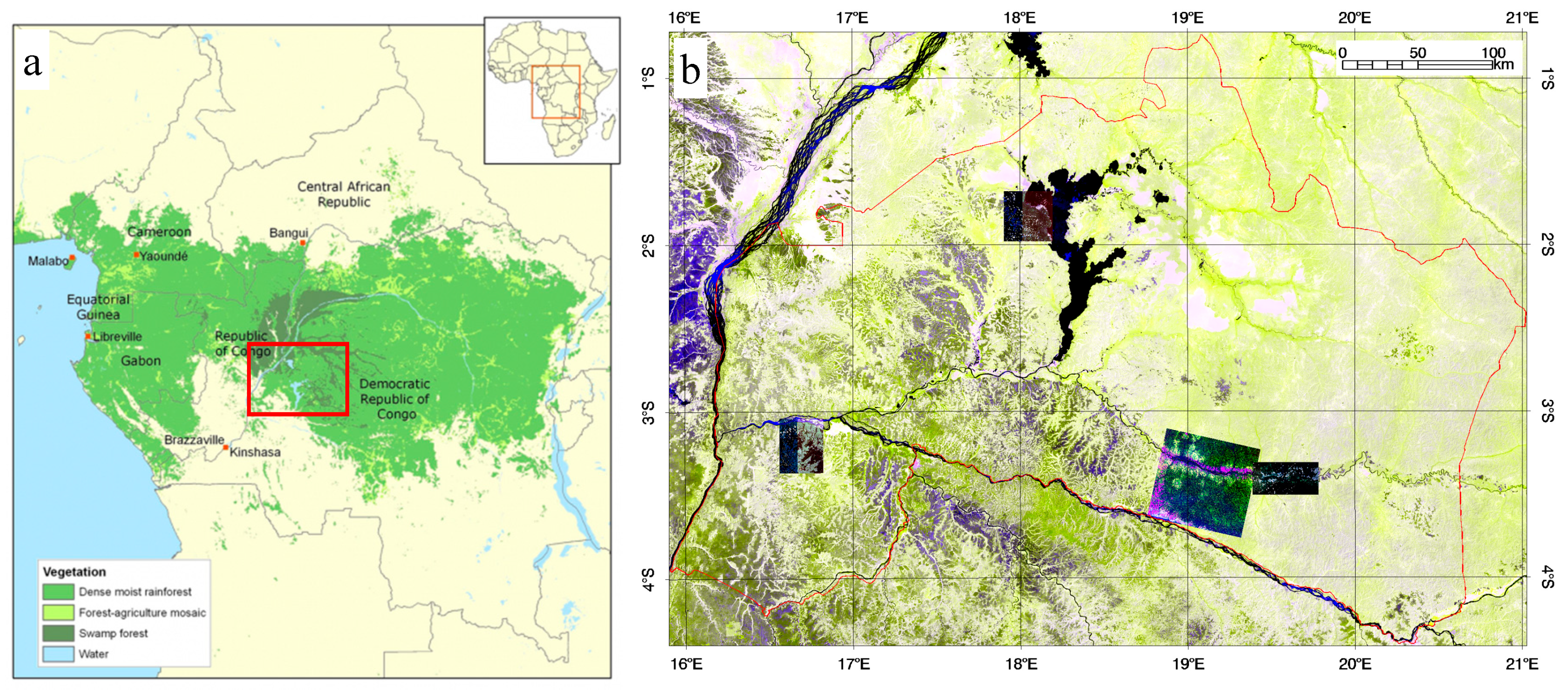
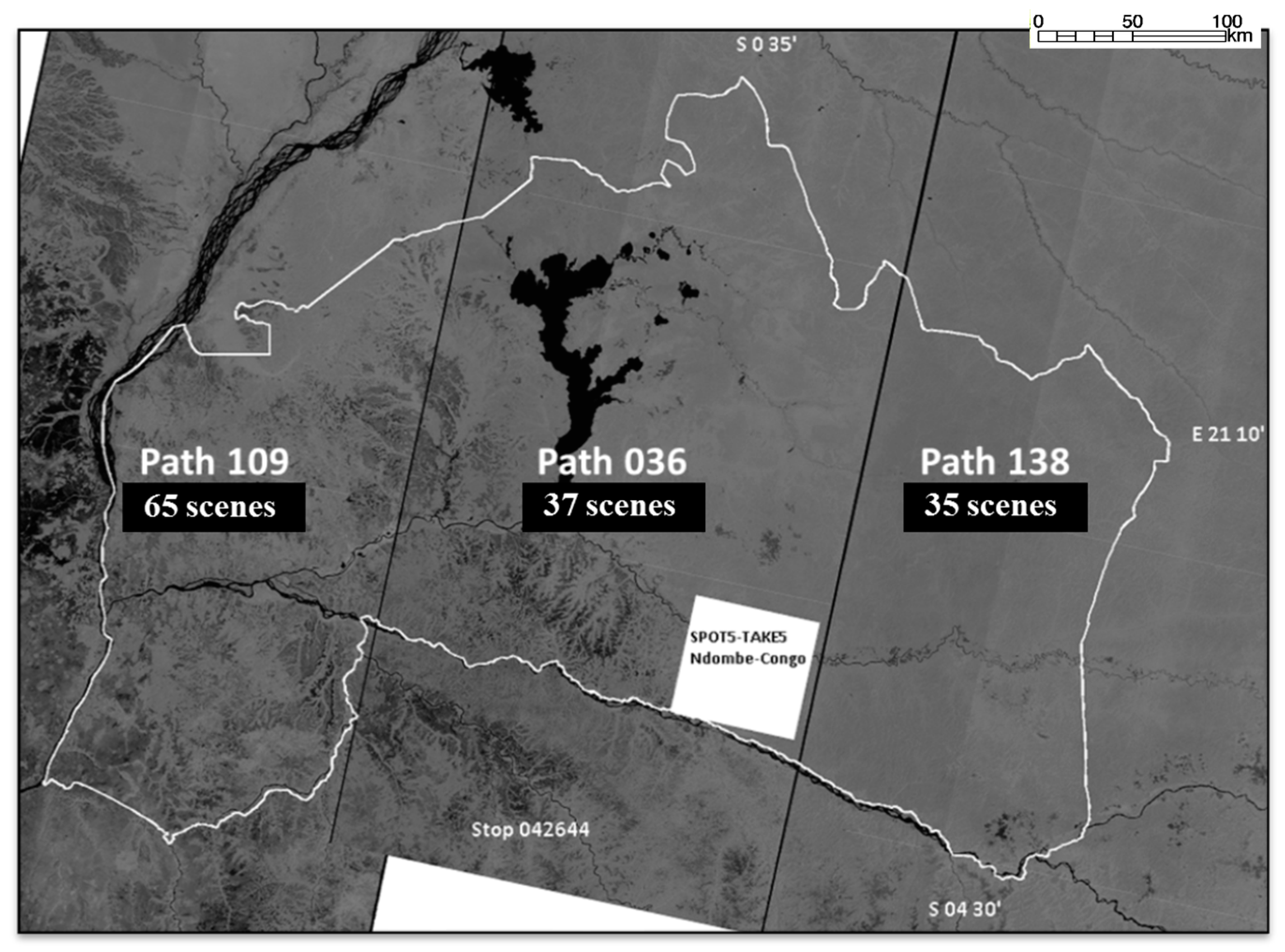


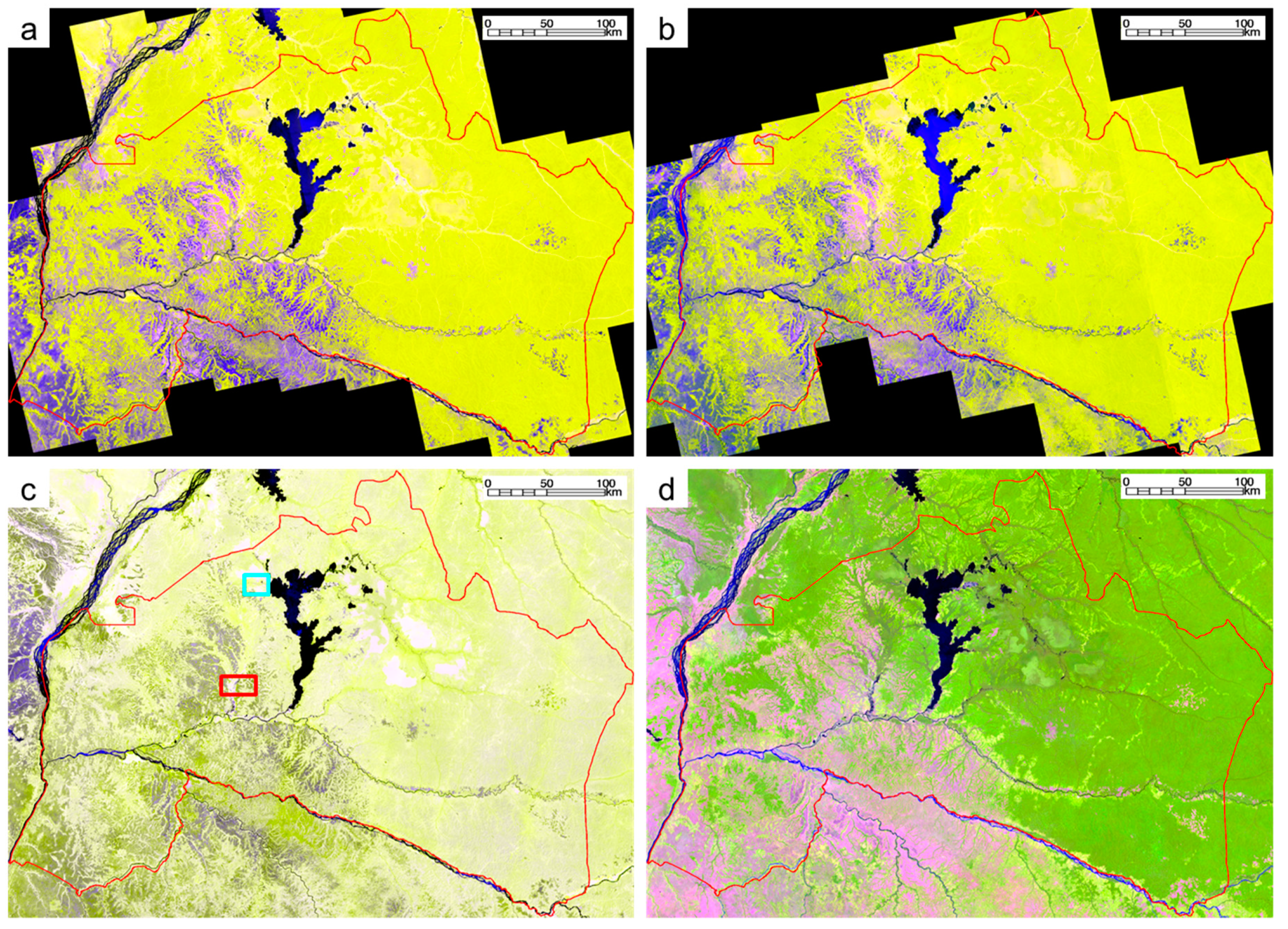
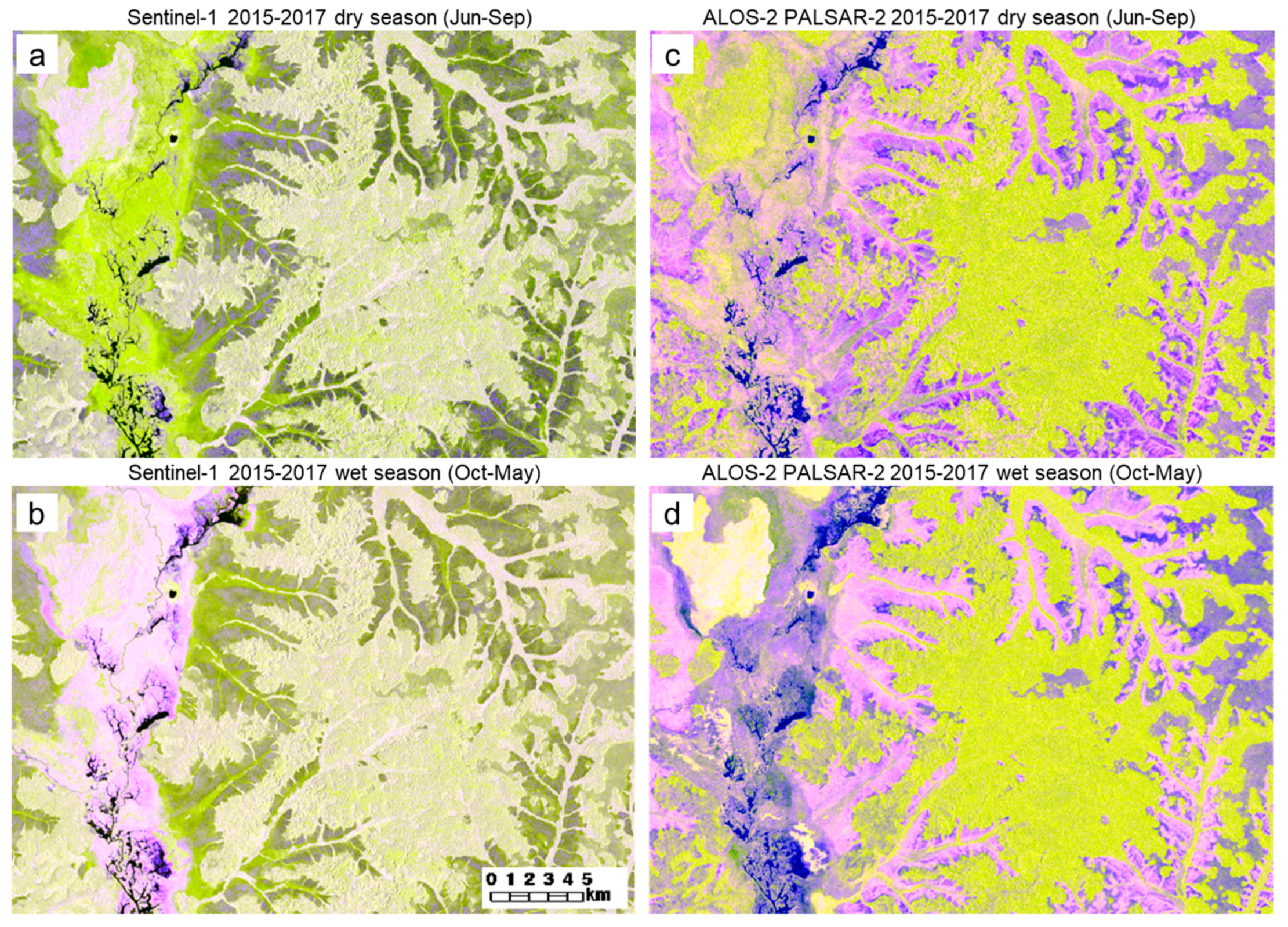
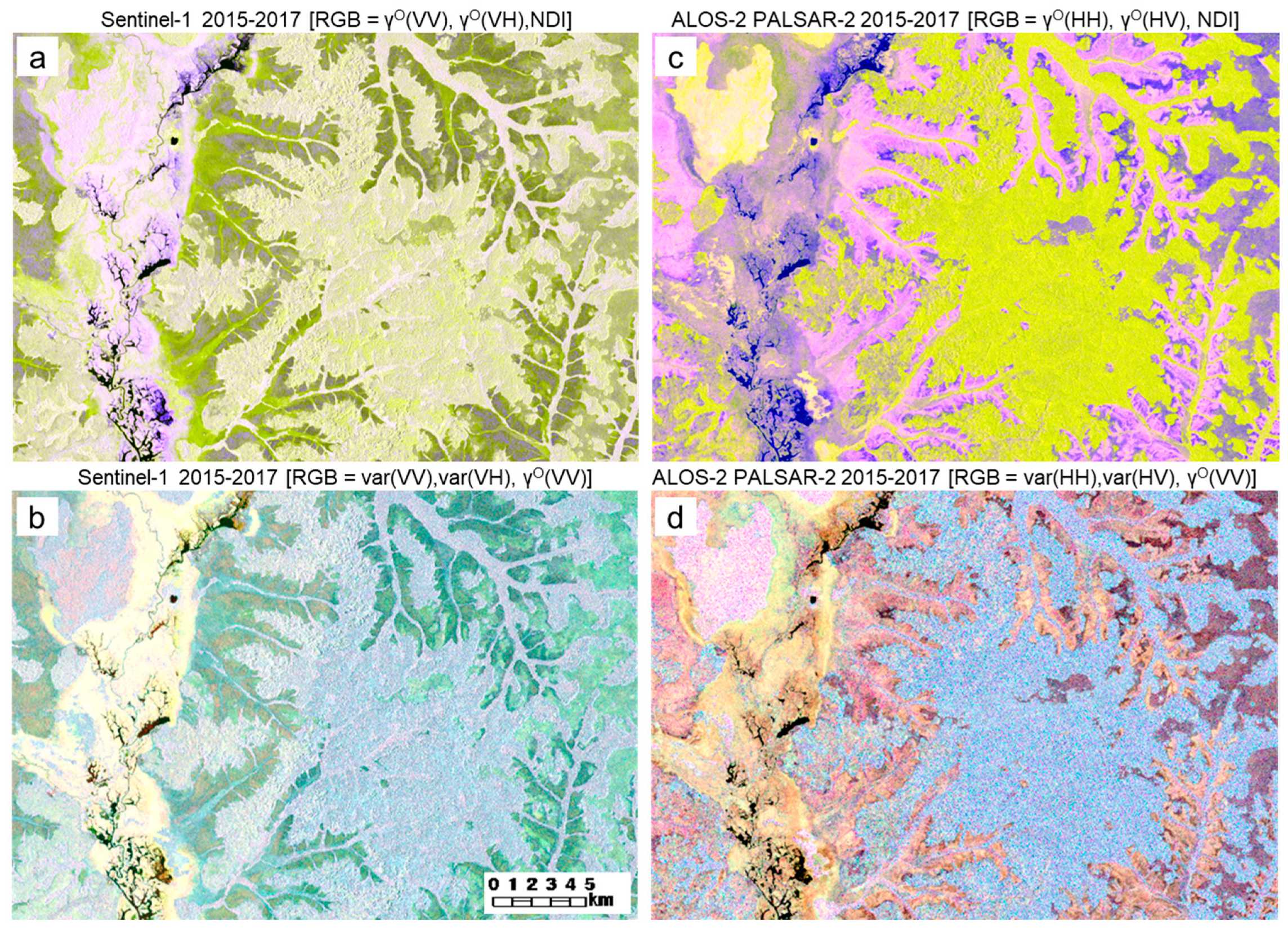
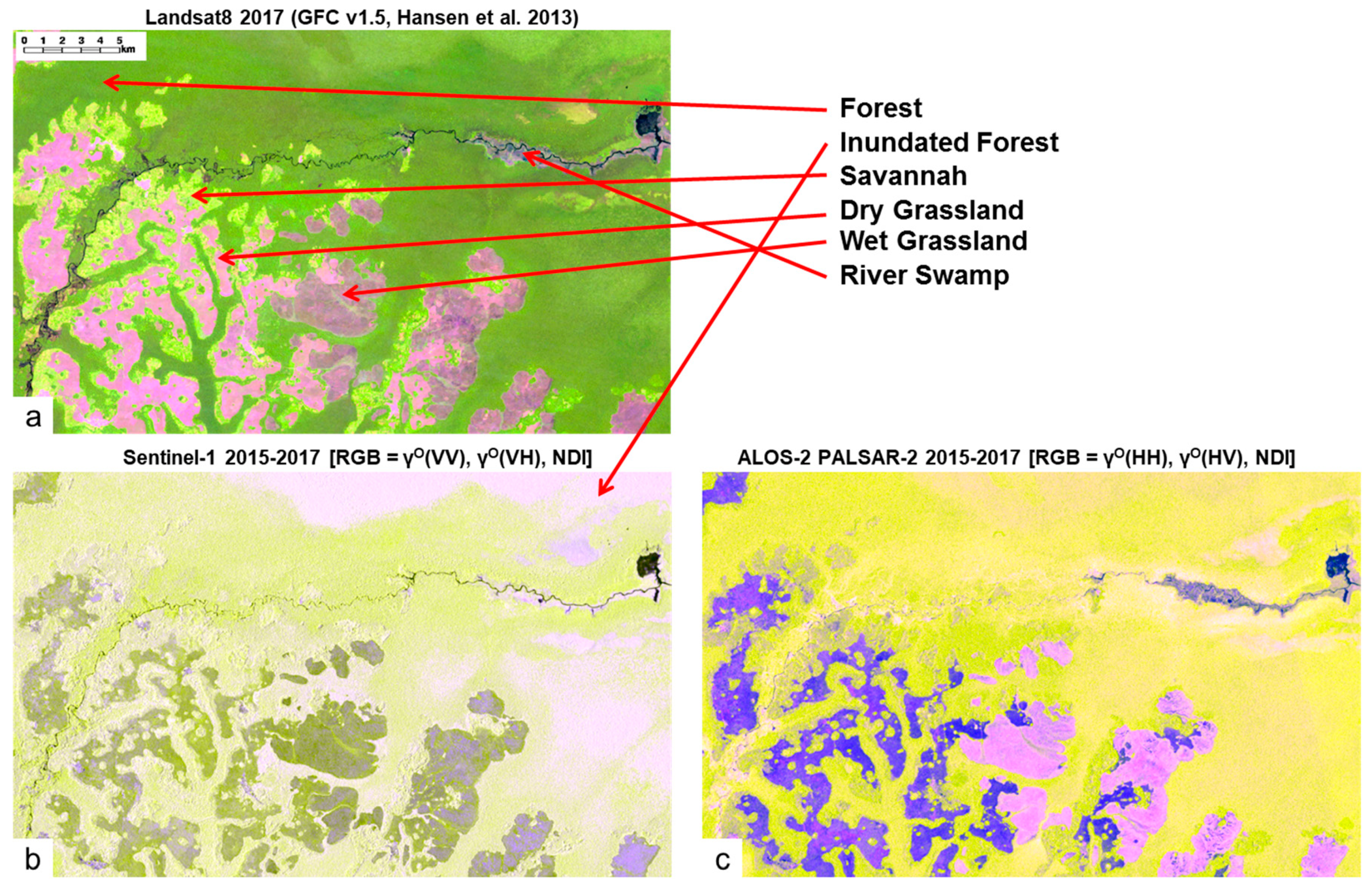
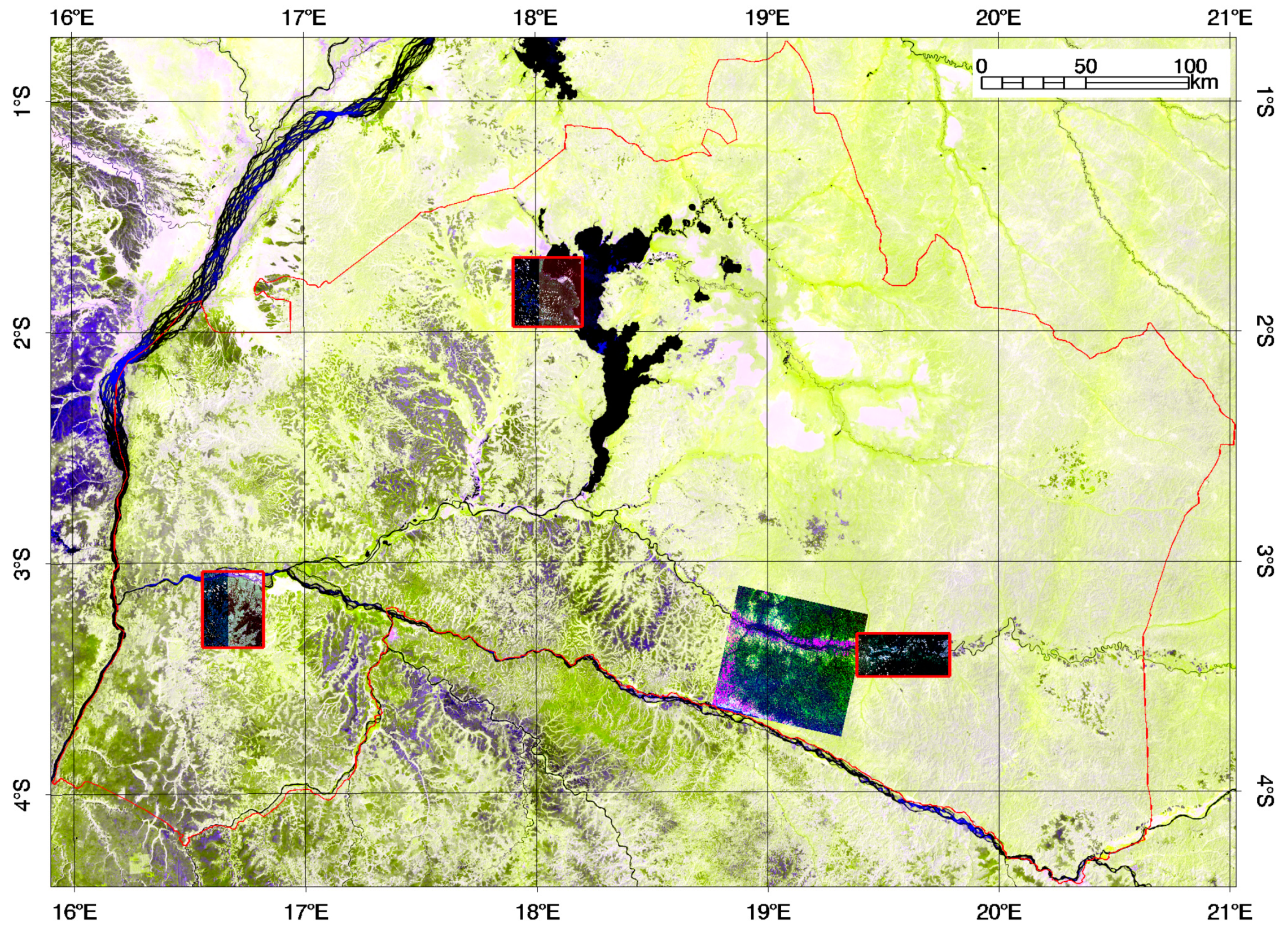
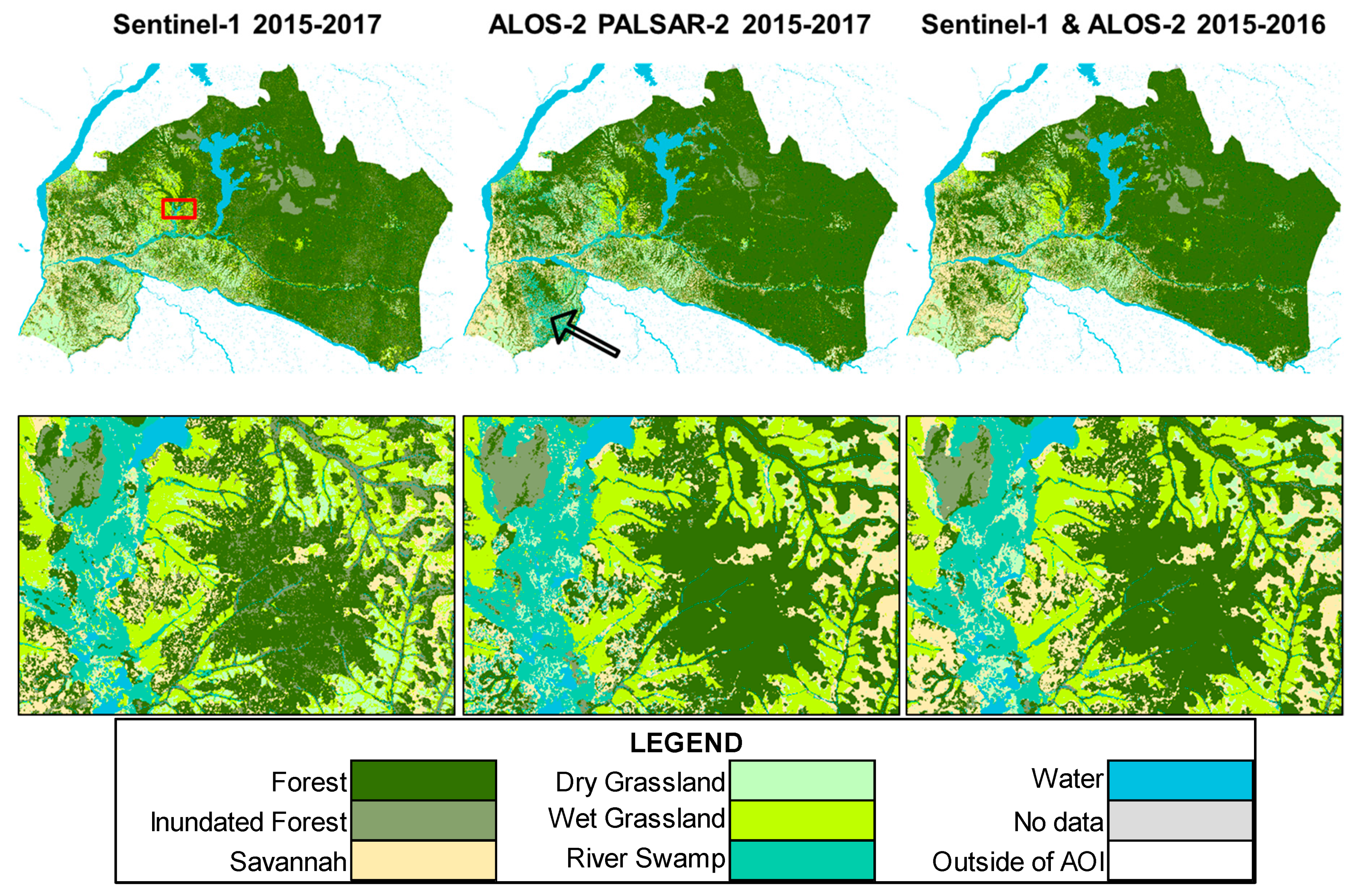
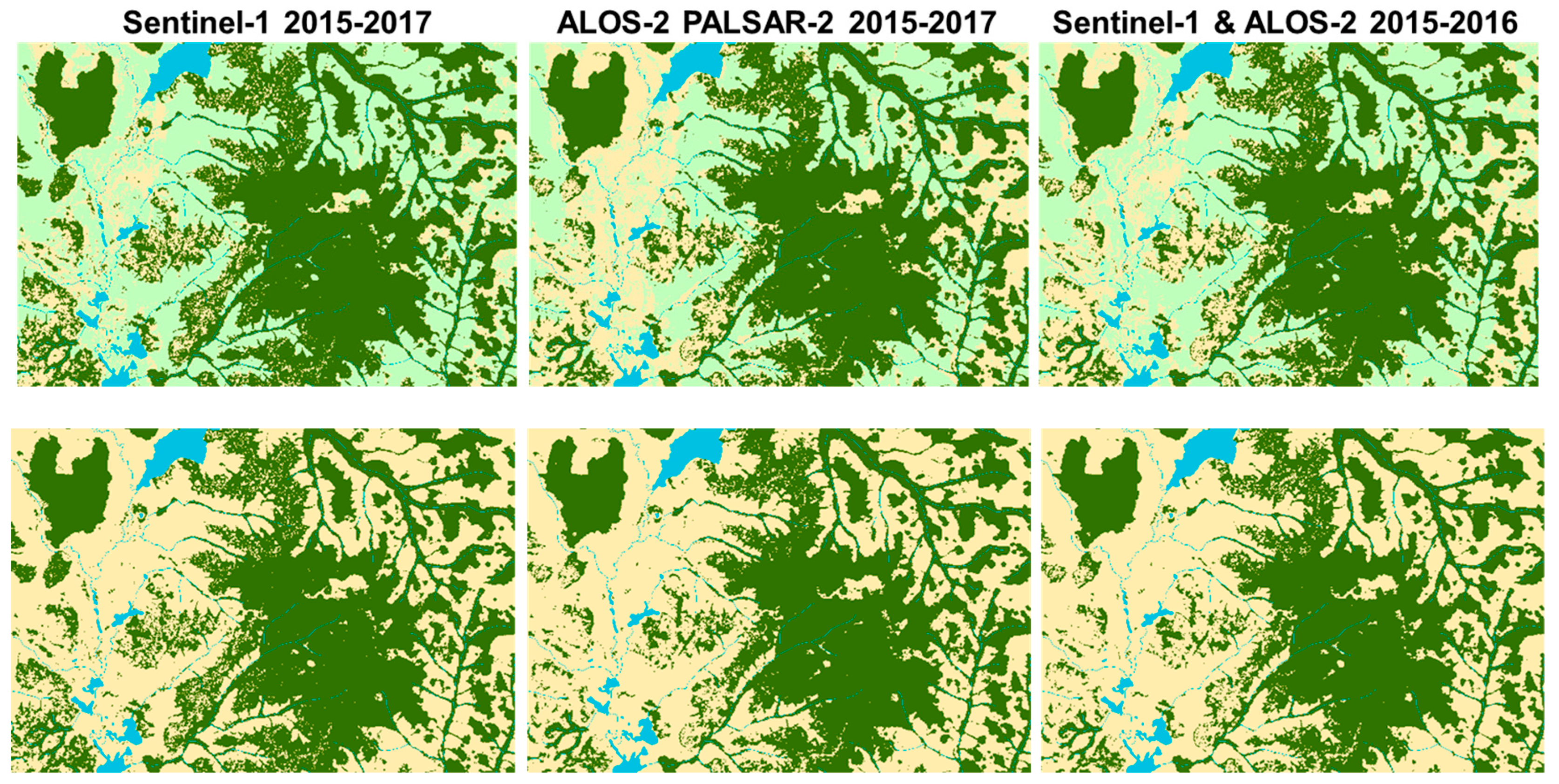
| Sensor | Variable Combination | Year(s) | Accuracy Kappa | FSG | FNF |
|---|---|---|---|---|---|
| ALOS PALSAR (L-band) | Single year Mosaic | 2010 | Accuracy | 88.10 | 91.23 |
| Kappa | 0.65 | 0.73 | |||
| Multi-year Mosaic | 2007–2010 | Accuracy | 89.07 | 91.34 | |
| Kappa | 0.68 | 0.73 | |||
| Seasonal (dry/wet) Mosaics | 2007–2010 | Accuracy | 89.72 | 91.88 | |
| Kappa | 0.71 | 0.76 | |||
| HH/HV Statistics (mean, variance) | 2007–2010 | Accuracy | 90.04 | 92.21 | |
| Kappa | 0.71 | 0.76 | |||
| ALOS-2 PALSAR-2 (L-band) | Single year Mosaic | 2017 | Accuracy | 89.61 | 92.21 |
| Kappa | 0.69 | 0.76 | |||
| Multi-year Mosaic | 2015–2017 | Accuracy | 89.61 | 92.42 | |
| Kappa | 0.69 | 0.76 | |||
| Seasonal (dry/wet) Mosaics | 2015–2017 | Accuracy | 89.07 | 91.77 | |
| Kappa | 0.69 | 0.75 | |||
| HH/HV Statistics (mean, variance) | 2015–2017 | Accuracy | 89.07 | 92.21 | |
| Kappa | 0.70 | 0.77 | |||
| Sentinel-1 (C-band) | Single year Mosaic | 2017 | Accuracy | 79.33 | 83.87 |
| Kappa | 0.42 | 0.52 | |||
| Multi-year Mosaic | 2015–2017 | Accuracy | 79.22 | 83.98 | |
| Kappa | 0.42 | 0.53 | |||
| Seasonal (dry/wet) Mosaics | 2015–2017 | Accuracy | 83.87 | 90.26 | |
| Kappa | 0.55 | 0.71 | |||
| VV/VH statistics (mean, variance) | 2015–2017 | Accuracy | 84.42 | 89.94 | |
| Kappa | 0.54 | 0.69 | |||
| ALOS-2 Palsar-2 (L-band) + Sentinel-1 (C-band) | Single year Mosaic | 2017 | Accuracy | 87.77 | 92.01 |
| Kappa | 0.64 | 0.76 | |||
| Multi-year Mosaic | 2015–2017 | Accuracy | 89.29 | 92.42 | |
| Kappa | 0.70 | 0.77 | |||
| Seasonal (dry/wet) Mosaics | 2015–2017 | Accuracy | 89.83 | 92.97 | |
| Kappa | 0.72 | 0.80 | |||
| HH/HV/VV/VH Statistics (mean, var) | 2015–2017 | Accuracy | 90.04 | 93.29 | |
| Kappa | 0.72 | 0.80 |
| Overall acc.: 90.04% Kappa: 0.72 | Reference VHR | |||||
|---|---|---|---|---|---|---|
| Forest | Savannah | Grassland | Total | User Acc. | ||
| Sentinel-1 /ALOS-2 | Forest | 697 | 40 | 11 | 748 | 93.18% |
| Savannah | 10 | 98 | 23 | 131 | 74.81% | |
| Grassland | 2 | 6 | 37 | 45 | 82.22% | |
| Total | 709 | 144 | 71 | 924 | ||
| Prod. Acc | 98.31% | 68.06% | 52.11% | |||
| Overall acc.: 93.29% Kappa: 0.80 | Reference VHR | ||||
|---|---|---|---|---|---|
| Forest | Non-Forest | Total | User Acc. | ||
| Sentinel-1 /ALOS-2 | Forest | 697 | 50 | 747 | 93.31% |
| Non-Forest | 12 | 165 | 177 | 93.22% | |
| Total | 709 | 215 | 924 | ||
| Prod. Acc | 98.31% | 76.74% | |||
| Sensor | Method | Year(s) | Accuracy Kappa | FNF |
|---|---|---|---|---|
| Landsat-7 | 50% tree cover GFC v1.5 [6] | 2010 | Accuracy | 88.64% |
| Kappa | 0.64 | |||
| Landsat-8 | 50% tree cover | 2016 | Accuracy | 89.07% |
| GFC v1.5 [6] | Kappa | 0.68 | ||
| Landsat-8 | 30% tree cover GFC v1.5 [6] | 2016 | Accuracy | 81.28% |
| Kappa | 0.35 | |||
| ALOS PALSAR | JAXA [32] | 2010 | Accuracy | 87.88% |
| Kappa | 0.61 | |||
| ALOS-2 PALSAR-2 | JAXA [32] | 2015 | Accuracy | 87.65% |
| Kappa | 0.59 | |||
| ALOS PALSAR | HH/HV Statistics (mean, variance) | 2007–2010 | Accuracy | 92.21% |
| Kappa | 0.76 | |||
| ALOS-2 PALSAR-2 | HH/HV Statistics (mean, variance) | 2015–2017 | Accuracy | 92.21% |
| Kappa | 0.77 | |||
| Sentinel-1 (C-band) | Seasonal dry/wet mosaics | 2015–2017 | Accuracy | 90.26% |
| Kappa | 0.71 | |||
| ALOS-2 and S1 | HH/HV/VV/VH Statistics (mean, var) | 2015–2017 | Accuracy | 93.29% |
| Kappa | 0.80 |
© 2019 by the authors. Licensee MDPI, Basel, Switzerland. This article is an open access article distributed under the terms and conditions of the Creative Commons Attribution (CC BY) license (http://creativecommons.org/licenses/by/4.0/).
Share and Cite
Haarpaintner, J.; Hindberg, H. Multi-Temporal and Multi-Frequency SAR Analysis for Forest Land Cover Mapping of the Mai-Ndombe District (Democratic Republic of Congo). Remote Sens. 2019, 11, 2999. https://doi.org/10.3390/rs11242999
Haarpaintner J, Hindberg H. Multi-Temporal and Multi-Frequency SAR Analysis for Forest Land Cover Mapping of the Mai-Ndombe District (Democratic Republic of Congo). Remote Sensing. 2019; 11(24):2999. https://doi.org/10.3390/rs11242999
Chicago/Turabian StyleHaarpaintner, Jörg, and Heidi Hindberg. 2019. "Multi-Temporal and Multi-Frequency SAR Analysis for Forest Land Cover Mapping of the Mai-Ndombe District (Democratic Republic of Congo)" Remote Sensing 11, no. 24: 2999. https://doi.org/10.3390/rs11242999
APA StyleHaarpaintner, J., & Hindberg, H. (2019). Multi-Temporal and Multi-Frequency SAR Analysis for Forest Land Cover Mapping of the Mai-Ndombe District (Democratic Republic of Congo). Remote Sensing, 11(24), 2999. https://doi.org/10.3390/rs11242999




